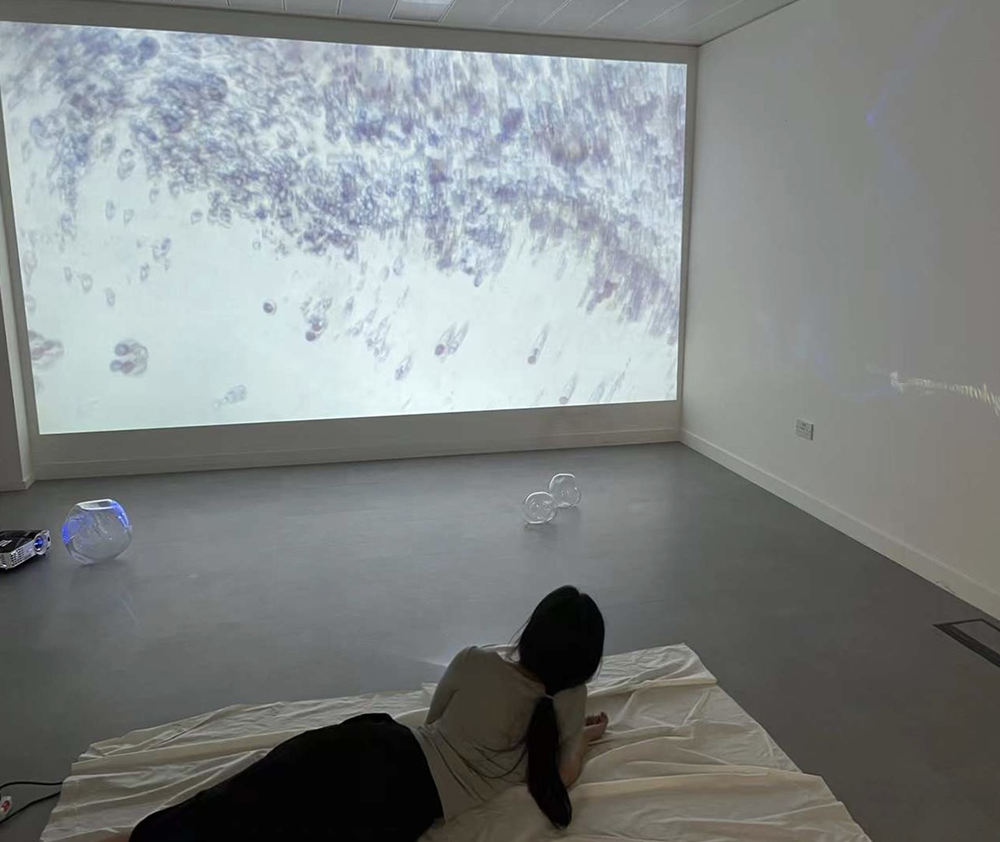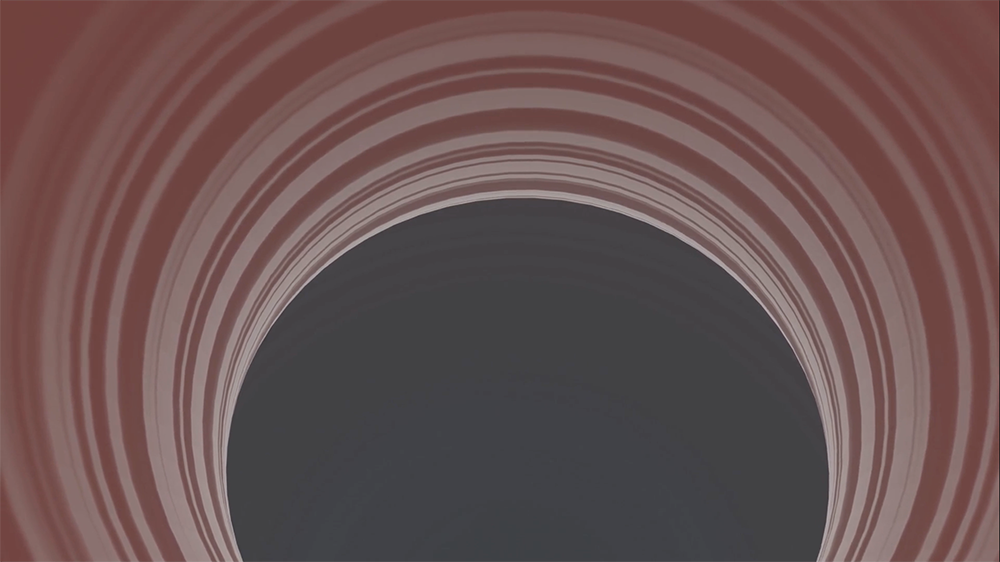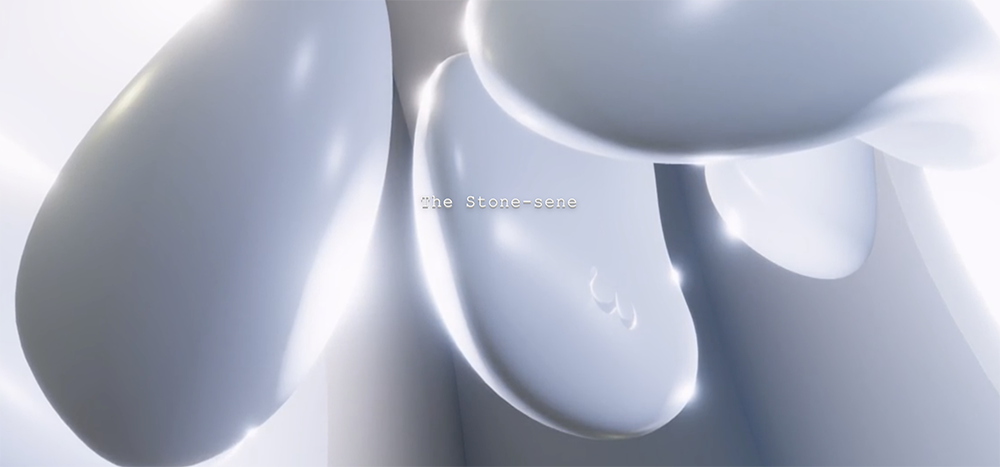Chunyi Shen (b. 1998, Chengdu, China) is a London-based transmedia artist. She holds a Master’s degree in Digital Direction from the Royal College of Art. Shen’s work has been showcased in prestigious international exhibitions, including the IRCAM at the Centre Pompidou, Outernet London, and London Craft Week.
Born: Chengdu, China
Now: United Kingdom
LinkedIn | website | RCA
INTERVIEW
Your work often explores the intersections between human and nonhuman entities. How did you first become interested in themes of posthumanism and rhizomatic landscapes?
My interest in posthumanism and rhizomatic landscapes developed from my fascination with the interconnectedness of humans, nature, and technology. Growing up in a world shaped by digital advancements, I began to question humanity’s role in the ecological system. Posthumanism, which challenges human-centric perspectives and emphasizes the agency of nonhuman entities, deeply resonated with me. The concept of rhizomatic landscapes, particularly inspired by Deleuze and Guattari, appealed to my interest in non-hierarchical, fluid systems. I saw parallels in both natural ecosystems and digital environments, where everything is interconnected and constantly evolving. My work began to explore how nonhuman entities—whether biological like slime mold or technological like AI—could serve as metaphors for these complex, decentralized networks. Posthumanism and rhizomatic landscapes became central to my artistic exploration of the evolving relationship between humans, the environment, and technology.

How does multispecies ethnography shape your artistic approach, and how do you select the organisms or entities that feature in your projects?
Multispecies ethnography has profoundly shaped my artistic approach by encouraging me to think beyond human-centered perspectives and consider the agency of nonhuman entities. It invites a deeper exploration of how different species, both organic and digital, engage with their environments, revealing complex networks of interdependence. This approach aligns with my belief that nature and technology are interconnected, and that art can challenge the boundaries between humans and nonhuman entities. When selecting organisms or entities for my projects, I look for those that offer metaphorical richness and challenge traditional hierarchies. For example, slime mold—an organism that defies typical categories of life—represents decentralized, non-hierarchical systems, which mirror the interconnectedness I aim to highlight in my work. Similarly, I explore artificial intelligence as a digital “entity” to examine questions of consciousness, agency, and nonhuman intelligence. Through these selections, I aim to reflect the interwoven and dynamic relationships within both natural and virtual ecosystems.

Your project Ritual and Healing has been showcased in various locations, including IRCAM at the Pompidou Center. What message do you hope to convey with this series?
Ritual and Healing, co-created with Savyna Darby and Mamoru Watanabe, is an audiovisual exploration of the natural world’s struggle under human dominance. Through an interplay of light, shadow, sound, and form, it conveys a devastated ecology while evoking deep human emotions. By blending diverse frequencies and metaphors, the work invites viewers to experience nature not as an object but as an active, expressive entity, questioning the boundaries between subject and object. Many have reported a sense of healing from the immersive experience.
Recently, Ritual and Healing was exhibited at the 2024 China-UK Tech Summit, where it engaged global leaders in technology and the arts on issues of ecological responsibility. This platform and an interview with CGTN Europe reinforced how art can bridge technology and environmental discourse, resonating with audiences on a profound level and contributing to the broader dialogue about the future of art, nature, and identity.

Your recent work, The Stonecene, explores themes of physical and virtual realities. How do you envision the relationship between these realms in a posthuman future?
The piece explores this relationship through the digital recreation of Stonehenge, which serves as a symbol of ancient memory, resonance, and collective consciousness. The work incorporates sound frequencies and vibrations, drawing from the idea that everything in the universe—whether matter or energy—is in constant motion at a molecular level. This is reflected in string theory, which posits that the fundamental building blocks of reality are tiny, vibrating strings rather than discrete particles. In The Stonecene, these vibrations are represented as sonic frequencies that permeate both the physical and virtual spaces, linking them together. The sound frequencies are not mere background elements; they become a driving force, emphasizing the interconnectedness between the material world and the virtual. Through this integration of sound and vibration, I aim to create an immersive experience where the viewer feels the resonance of the space—both physically and digitally. This approach suggests that in a posthuman world, the virtual and the physical will no longer be separate; they will exist as intertwined vibrations in a unified, ever-evolving system.

In your internship at Johns Howkins Creative Ecology Lab, you researched artificial intelligence. How did this experience impact your views on AI and its role in art?
As a research assistant at the Johns Howkins Creative Ecology Lab gave me a deeper understanding of AI’s potential and limitations in the context of art. Researching artificial intelligence from an ecological perspective showed me that AI is not just a tool, it’s an evolving, adaptive system capable of generating insights and relationships that go beyond human creativity. This experience reshaped my views on AI, highlighting its potential to enhance artistic exploration while also raising questions about authenticity and authorship in art. One key takeaway was AI’s capacity to reveal patterns and connections within vast datasets—something I found particularly compelling for projects involving complex ecosystems or multi-species perspectives. However, I also became more aware of AI’s ethical and philosophical implications, especially regarding bias and agency. This experience reinforced my belief that artists have a responsibility to engage with AI critically, using it to amplify human insight while remaining mindful of its impact on representation and creativity.

For your project with The Future Laboratory, Tsinghua University, you created an interactive digital replica of the Tanabe plum system. How did this project challenge or expand your understanding of digital landscapes?
Creating an interactive digital replica of the Tanabe plum system in collaboration with The Future Laboratory, Tsinghua University deepened my understanding of digital landscapes as tools for cultural preservation and ecological storytelling.
This project involved translating a complex, centuries-old agricultural system into an immersive digital environment. My work on this project broadened my perspective on how digital platforms, such as the ROBLOX can serve as cultural resources, making intricate systems accessible to wider audiences.
Recognized as a Globally Important Agricultural Heritage System (GIAHS) by the FAO, the Tanabe plum system exemplifies a harmonious integration of human society with the natural environment. It embodies traditional knowledge, biodiversity, and the unique local landscapes that have developed over centuries. This experience highlighted the unique ways digital landscapes can capture and transform traditional knowledge.

What advice would you give to emerging artists interested in exploring transmedia storytelling?
For artists diving into transmedia storytelling, my main advice is to focus on the core message or theme you want to communicate and let that guide your choice of media. Transmedia storytelling thrives when each medium—digital, visual, or interactive—adds a unique perspective to the narrative, creating a richer experience across platforms. Start with a clear concept, then explore how different media can amplify various aspects of your story.
Experimentation is essential. Be open to trial and error, as transmedia art often involves testing new tools and formats.
Don’t be afraid to combine traditional art with digital elements like VR, soundscapes, or interactive components. This process will help you discover the mediums that resonate best with your message.
Finally, stay curious and collaborate with others from diverse fields. Transmedia storytelling benefits from interdisciplinary insights, so connecting with technologists, scientists, or writers can deepen your work and push your storytelling into new, innovative realms. Embrace a learning mindset and trust that each experiment will bring you closer to creating a cohesive, multi-dimensional narrative.